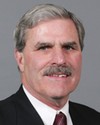I won't go over all of the details of the facts, but 4% of gross domestic product is a number we've accounted for over the last 35 years--between 3.5% and 4% of gross domestic product as an industry. We're very important to both the rail system and the port system in terms of overall loadings, freight revenue, etc., and there's quite an extended range of companies that supply services. For those 2,300 suppliers, we use a cut-off point. More than 50% of their business is done with the mining industry. So if you do 10% of your business with the mining industry, we could probably triple or quadruple that number in terms of the reach the mining industry has throughout the Canadian economy. And we're significant investors in research and development.
I will take a bit of time on the next slide, on the theoretical framework. I think it helps situate what we're trying to do as an industry and what I believe we're trying to also accomplish as a society. I've adapted this particular slide from the work of Herman Daly, a name well known in the environmental area and in natural capital, and some additional work by Veronica Alvarez Compillay, in work included in “Indicators of Sustainability for the Mineral Extractive Industries”. I've also drawn on some other authors as well and work at the World Bank.
To situate the traditional Herman Daly diagram of sustainability in terms of a theoretical framework is that pyramid you see in the centre of this diagram, how you move from natural capital, and you transform it with science and technology, economic policy, into produced capital, which would be what industry does in producing raw materials, work, etc. The financial side of that would go into and be reinvested by government in terms of its take into social and human capital, thereby, if it's all done properly, resulting in improved welfare in the Canadian economy and society in general.
That sort of beginning point has become more sophisticated and more detailed in terms of how economists and environmentalists theoretically look at this evolution. This is why I have given you the box with the arrows between natural capital, financial capital, human capital, and social capital, because that captures a bit more of the flavour of discussions over the last five years in terms of how this original sort of pyramid structure has broken down into more sophisticated compartments, although not losing sight of what that pyramid is trying to demonstrate in the centre.
I would even say that in the social capital, for instance, we now oftentimes break out into a subcomponent of institutional capital as well, or societal institutional capital, where if we reinvest properly with the capital that is derived from other parts of the system, we improve the institutional governance structures of society. That's part of public policy, but part of what we can also assist in.
I'll first of all explain a bit on the natural capital side. We're really talking about the flows in stocks of natural resources and natural services, water, flora, fauna, minerals, and metals. So that's what we put in the natural capital. That's not a static situation, because through the work of the sun we receive energy. It transforms into additional biota growth, etc. We're a bit more constrained in terms of how we look at the minerals and metal side of that issue, or fuels.
We transform natural capital into other forms of capital through the application of financial capital, economic policy, and social policy. Then we produce other forms of capital. We invest in that, and governments invest particularly in human capital through education, training, skills development, health, wealth, communication, knowledge. By the same token, we focus considerably, both as a society and on social capital as well, in terms of investing some of that financial wealth derived from other produced forms and natural forms of capital into social capital. I'll define that, and I'll use an OECD definition, which comes from a document called “Policies to Enhance Sustainable Development”, published in 2001.
The OECD's definition of social capital refers to the networks, shared norms, values, and understandings that facilitate cooperation amongst groups. It's social cohesion, commonality of purpose. Why I also break out and why a lot of the literature now talks about a subunit of that being institutional capital is that in some cases you need that institutional infrastructure to provide the platform for these social norms to work and coalesce and “cohese” more and improve. So there's a lot of subtlety to this.
If I were to really be totally complicating the sorts of debates that take place in the literature, we would also draw arrows going back and forth between natural capital and human capital, and social capital and financial capital as well, simply because with an increase in knowledge, we can work better to protect that natural capital. We can reclaim land and re-enhance natural capital. By the same token, through social capital and traditional knowledge on the first nations side, for example, that can be brought to bear to improve natural capital as well. So there is a very good reason that I show arrows going in both directions to all these boxes.
On the governance side and what government at both the provincial and federal levels and governments around the world do, and what we as industry do...we apply science and technology, economic policy, public policy, and so on, to ensure that we get the proper linkages and the optimum benefits out of the transformation of capital to these various boxes. This sort of diagram fits with where we were with the Earth Summit in 1992 and Agenda 21 on sustainable development. It fits with the Brundtland definition of bringing to bear a three-pronged approach of economic, social, and environmental foci to how we undertake economic and social development at the end of the day.
Although this is a complicated diagram--and I'll make just one other point about it--in looking at this, you have definitions of weak sustainability and strong sustainability. I don't want to dwell too much on those, but I'll put them on the record because I think you may end up with some appreciation for them at the end, because they are important.
On weak sustainability, the theoreticians would call that where your overall stock of capital, those forms of capital that I've laid out for you, remain in the development process at least constant over time. I'm using the definitions that are in a Eggert paper out of “Sustainable Development and the Future of Mineral Investment”, which is in actual fact a UNEP, or United Nations Environment Programme, publication. Just again, this is all well grounded in the literature.
Strong sustainability tends to focus on two elements, where it requires both the overall capital stock but also the natural resource stock to remain at least constant over time as well. So there is an argument within the literature that we need to pay particular attention to that natural capital stock.
So those are the theoretics. How do you go from that theoretical basis in terms of, for example, what we might do as an industry, the mining industry, which is dealing with a depletable resource...how do we operate in a sustainable manner or a manner that helps society achieve these goals of keeping this capital stock constant for growing so that we improve welfare at the end of the day?
That's really what this next part of my discussion is going to be about. I'm going to use the World Commission on Environment and Development--the Brundtland commission--definition of sustainable development, because that's at the heart of ours towards sustainable mining activity, where it's defined as “Development that meets the needs of the present without compromising the ability of future generations to meet their own needs”. That fits perfectly with that other diagram, because that is a long-term dynamic, and you want to achieve growth in welfare, improvements in welfare over time, but not at irreparable cost to any particular capital component.
As a bit more about where we are, our activity was launched in 2004 after four years of intensive work internally to MAC, the Mining Association of Canada. It's a condition of membership in terms of a commitment by our members to this process in reporting in metrics that I'm going to tell you about. But in its design to align our industry actions with priorities and values of communities of interests and by aligning with priorities and values of the communities where we operate, that reflects social cohesion. That's a commitment to enhancing that social capital, and we want to improve our reputation through improved performance, which is all about reducing our draw on natural capital and improving the financial capital side and the ability of governments and others to invest in human capital at the end of the day.
Our guiding principles are: to responsibly meet society's needs for minerals and metals; to be committed to sustainable development; to align our actions; to hold shared values; to offer ongoing protection of employees, communities, customers, and the natural environment.
I have brought the TSM report with me in English and French and have made it available at the back of the room, so I'm not going to go into detail on a lot of these. Just read through these; they're there for you.
We are committed in all aspects of our operations to respect human rights, to respect cultures, customs, and values, to adhere to best practices, to be responsive to community priorities, etc.
In this practical application, we have developed performance indicators, because part of the sustainable development equation at the end of the day is based on how you measure progress. How do you operationalize the guiding principles into metrics on the ground, so that you can demonstrate whether you're making progress or not?
That's exactly what the MAC TSM guiding principles and MAC activity are all about: developing performance indicators to respond to critical areas of performance that civil society has asked that we improve on. Our board has decided that it wants and needs measurable results, it wants to be accountable for its actions, and it needs to report on that progress and results, and by reporting, be accountable to the public.
It also will build credibility and trust with our community of interest, not on the basis of, “Believe us, we're here to do our best”, but in actual fact, to demonstrate through reporting on the important metrics that we are living up to our commitments.
The indicators in the first instance, because again this comes from the feedback of what our communities of interest.... You might use the term “stakeholders”, but first nations and our Inuit and Métis members prefer “communities of interest” rather than “stakeholders”. They see themselves as more than stakeholders and as governments, in many instances, in their own right, so I will use the longer form, “communities of interest”.
Clearly, one of the first things they wanted us to improve was the crisis management in communications around our activities, our external outreach and engagement with the local communities where we operate, and they wanted us to reflect those values and engage in much better response mechanisms and capture benefits at the local level.
Greenhouse gases and energy use is a major issue, and we have focused on that for quite a number of years.
Because of events in the nineties with respect to tailings failures outside of Canada, we were asked to focus on developing best practice and world-class guidance in the management of tailings facilities to ensure that those types of environmental problems did not repeat themselves. We have developed a due diligence approach in tailings management that is now a world-class document that is on the UNEP world website. We've made it available to the rest of the industry worldwide. It's best practice guidance.
This is quite an elaborate architecture that we have built in going from guiding principles to interpreting those principles and defining performance indicators. We are working on those two additional boxes, aboriginal relations and biodiversity. We have developed workshops and policy positions with our communities of interest over this year, and we will be developing the metrics next year.
Behind those metrics go reporting guides and performance reporting systems, and we will be moving to third-party verification in 2007. Again, it's going to be quite a sophisticated process, and it won't stop there. We're still in the process of building this architecture. But I give you an example here of the TSM public report—and as I say, both English and French copies are available—and we will be moving to external verification next year on our reporting.
Turning to its practical application, what it has done for us in general as an industry is drive performance, refocus and stimulate activity in the industry on performance gaps, draw attention to our goals and targets, and create a culture of achievement. This is all the business case for doing this. It identifies trends and allows us to compare ourselves with others, both worldwide and in other parts of the economy. It creates a culture of transparency in our activities and actions, and it helps to earn our social licence at the end of the day.
Let me turn to the oil sands side of that and the members of the Mining Association of Canada--and I can only speak for them here--Syncrude, Suncor, Shell Albian. They have been leaders in implementation towards sustainable mining. In many instances--not right across the board, but in many instances--they already had best practice world-class standards in energy and tailings management, external outreach, aboriginal relations, and crisis communications, and we have used their best practices to drive performance in other parts of the industry.
I won't spend a lot of time going over these facts about the oil sands industry and the position that Canada is in. You're going to have more knowledgeable people from Alberta and the oil sands and the petroleum sector I think in your subsequent meetings, who can talk in much more detail about this.
The level of revenues that we are potentially going to derive as an economy and as governments over the period of 20 to 25 years is quite staggering. The employment benefits and the benefits in terms of procurement policies right across the country are important. Even within aboriginal businesses, in 2005, the industry spent more than $310 million in contracts to source goods and services. There is a culture of achievement and entrepreneurial development in Alberta in the aboriginal community that I think is the envy of many other aboriginal communities across Canada. We're seeing the same thing take place in the diamond industry in northern Canada. We hope to see that replicated in the diamond industry in Ontario and in the mining industry in general. We are taking best practices from what the oil sands are doing, in terms of their community outreach and aboriginal engagement, and trying to duplicate that elsewhere.
The job creation is quite spectacular. I'll just draw some links back to the TSM performance indicators: aboriginal engagement with the oil sands, the work with the Athabasca Tribal Council, 1,500 aboriginal employees in permanent jobs in 2005. I mentioned the contract.
In the performance indicators we have under TSM, the oil sands are the top performers in external outreach and aboriginal relations. Syncrude is a recipient of the Progressive Aboriginal Relations Award from the Canadian Council for Aboriginal Business. They are doing their best, as we are, collectively, as an industry, by investing in aboriginal business development and human skills development and training. That's the human capital component of this. Allowing those communities to become self-sufficient in terms of their own economic future is building social capital. And again, it's the way it draws back to those linkages. The moneys that will flow to government on the financial side put government in a position to invest in human capital and social capital, at the end of the day, in a broader sense than just a regional sense.
On environmental stewardship--again, air, water, land--they are doing quite significant work in terms of both tailings management and biodiversity. These are all regulated areas at both the provincial and federal levels in terms of air, water, and land. In the case of water, Suncor has doubled production over the last five years, but their water usage has remained the same. We've become much more efficient in water usage, and clearly, that's one of the key goals we collectively have as an industry. It's also acute for this part of Alberta. Again, they are very strong performers under the TSM with respect to those elements.
On responsible energy use and energy management, they are leaders, and many of our mining companies have been out to Alberta to look at the energy efficient processes they have in place. In many cases, they have led the way. There are still some big challenges, which I'll get to in my concluding remarks. They continue to push the envelope in sulphur capture, nitrogen oxide and particulate reduction, and greenhouse gas efficiencies and reductions.
I'll conclude my remarks. I've taken you through the practical side, but I wanted to really fit this within a theoretical context as well.
Quite frankly, in terms of the challenge we have as Canadians in looking at where we need to go next with development in Canada, the solution isn't in ensuring the oil sands, mining, or harvesting of any natural resource.... If we're going to make those part of the sustainability equation, the solution is not rendering these resources valueless by stopping development. It's ensuring that we have good public policy in place to optimize the human, social, and financial capital components while minimizing the environmental cost and the draw on natural capital. For the oil sands, that means in a general sense that we need to focus on public–private research, with added emphasis on greenhouse gas capture and sequestration—particularly the CO2 component of that—and continued pursuit of energy efficiencies in production processes.
I'll end with a final comment that is a quote from Fred Carmichael, president of the Gwich'in Tribal Council and chair of the Aboriginal Pipeline Group, in a speech on October 24 of this year to the Canadian Council for Aboriginal Business. He stated, “I believe the Creator put the resources under and on the land so that our people can continue to make a decent living.” That comes back to the welfare and economic possibilities that these resources represent, but we have to do it in a responsible manner.
As an industry, we are committed to getting there. We're not at an end state of grace by any means. We have lots of elements to continue to work on, but you have a commitment from this industry to continue to improve, to continue to see those best practices evolve, and to work with government on some of the step change process realities that we need at the end of the day.
Thank you.













